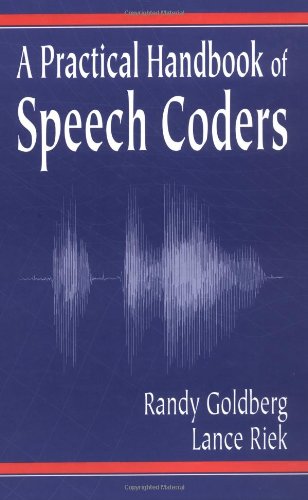Randy Goldberg, Lance Riek9780849385254, 0-8493-8525-3
Table of contents :
A Practical Handbook of Speech Coders……Page 2
Authors……Page 4
Acknowledgments……Page 6
Table of Contents……Page 7
List of Figures……Page 11
List of Tables……Page 15
Table of Contents……Page 0
1 Introduction……Page 18
2.1 The Speech Chain……Page 22
2.2 Articulation……Page 25
2.2.1 Excitation……Page 26
2.2.2 Vocal Tract……Page 28
2.2.3 Phonemes……Page 31
2.3 Source-Filter Model……Page 46
3.1 Sampling the Speech Waveform……Page 50
3.2 Systems and Filtering……Page 53
3.3 Z-Transform……Page 55
3.4 Fourier Transform……Page 57
3.5 Discrete Fourier Transform……Page 59
3.5.1 Fast Fourier Transform……Page 60
3.6 Windowing Signal Segments……Page 62
4.1 Sound Propagation in the Vocal Tract……Page 68
4.1.1 Multiple-Tube Model……Page 72
4.2 Estimation of LP Parameters……Page 74
4.2.1 Autocorrelation Method of Parameter Estimation……Page 75
4.2.2 Covariance Method……Page 76
4.3.2 Line Spectral Frequencies……Page 77
4.4 Examples of LP Modeling……Page 78
5 Pitch Extraction 65……Page 82
5.1 Autocorrelation Pitch Estimation……Page 83
5.1.1 Autocorrelation of Center-Clipped Speech……Page 85
5.1.2 Cross Correlation……Page 86
5.2 Cepstral Pitch Extraction……Page 89
5.3 Frequency-Domain Error Minimization……Page 93
5.4.1 Median Smoothing……Page 94
5.4.2 Dynamic Programming Tracking……Page 95
6.1 The Basilar Membrane: A Spectrum Analyzer……Page 97
6.2 Critical Bands……Page 98
6.3 Thresholds of Audibility and Detectability……Page 101
6.4.1 Simultaneous Masking in Frequency……Page 103
6.4.2 Temporal Masking……Page 105
7 Quantization and Waveform Coders……Page 108
7.1.1 Uniform Pulse Code Modulation (PCM)……Page 109
7.2 Nonlinear Quantization……Page 112
7.3 Differential Waveform Coding……Page 113
7.3.1 Predictive Differential Coding……Page 115
7.3.2 Delta Modulation……Page 116
7.4.2 Adaptive Differential Pulse Code Modulation (ADPCM)……Page 118
7.5 Vector Quantization……Page 122
7.5.1 Distortion Measures……Page 124
7.5.2 Codebook Training……Page 126
7.5.3 Complexity Reduction Approaches……Page 127
7.5.4 Predictive Vector Quantization……Page 129
8 Quality Evaluation……Page 133
8.1.1 Signal-to-Noise Ratio……Page 134
8.2 Subjective Measures……Page 135
8.2.1 Intelligibility……Page 136
8.2.2 Quality……Page 137
8.2.3 Background Noise and Channel Conditions……Page 139
8.3 Perceptual Objective Measures……Page 140
A Practical Handbook of Speech Coders……Page 142
9 Voice Coding Concepts……Page 143
9.1 Channel Vocoder……Page 145
9.1.1 Implementations of the Channel Vocoder……Page 146
9.2 formant Vocoder……Page 148
9.3.1 The Sinusoidal Model……Page 150
9.3.2 Sinusoidal Parameter Analysis……Page 151
9.4 Linear Prediction Vocoder……Page 153
9.4.1 Federal Standard 1015, LPC-10e at 2.4 kbit/s……Page 157
10 Linear Prediction Analysis by Synthesis……Page 160
10.1 Analysis by Synthesis Estimation of Excitation……Page 161
10.2 Multi-Pulse Linear Prediction Coder……Page 162
10.3 Regular Pulse Excited LP Coder……Page 163
10.4 Code Excited Linear Prediction Coder……Page 164
10.4.1 CELP Concept……Page 166
10.4.2 CELP Computational Efficiency Improvements……Page 167
10.4.3 Adaptive Postfiltering……Page 169
10.4.5 ITU-T G.728 Low Delay CELP at 16 kbit/s……Page 170
10.4.6 ITU G.723.1 algebraic CELP/Multi-Pulse Coder at 5.3/6.3 kbit/s……Page 171
10.4.7 ETSI GSM Enhanced Full Rate Algebraic CELP at 12.2 kbit/s……Page 173
10.4.8 IS-641 EFR 7.4 kbit/s Algebraic CELP for IS-136 North American Digital Cellular……Page 174
10.4.9 ETSI GSM Adaptive Multi-Rate Algebraic CELP from 4.75 to 12.2 kbit/s……Page 175
11.1 Multi-Band Excitation Vocoder……Page 178
11.1.1 Multi-Band Excitation Analysis……Page 179
11.1.2 Multi-Band Excitation synthesis……Page 182
11.1.3 Implementations of the MBE Vocoder……Page 184
11.2 Mixed Excitation Linear Prediction Coder……Page 186
11.2.1 Federal Standard MELP Coder at 2.4 kbit/s……Page 189
11.2.2 Improvements ot MELP Coder……Page 195
11.3 Split Band LPC Coder……Page 197
11.3.1 Bit Allocations and Quality Results……Page 198
11.4.1 HVXC Encoder……Page 200
11.4.2 HVXC Decoder……Page 203
11.5 Waveform Interpolation Coding……Page 206
11.5.1 WI Coder and Decoder……Page 207
11.5.2 quantization of SEW and REW……Page 209
11.5.3 Performance and Enhancements……Page 210
A Practical Handbook of Speech Coders……Page 213
12.1 Auditory Processing of Speech……Page 214
12.1.1 General Perceptual Speech Coder……Page 215
12.1.2 Frequency and Temporal Masking……Page 216
12.1.3 Determining Masking Levels……Page 218
12.2 Perceptual Coding Considerations……Page 220
12.2.2 Sound Quality of Signal Components……Page 221
12.2.3 MBE Model for Perceptual Coding……Page 222
12.3 Research in Perceptual Speech Coding……Page 223
A.1 Information on Coding Standards……Page 227
A.2 Technical Conferences……Page 229
References……Page 232

Reviews
There are no reviews yet.